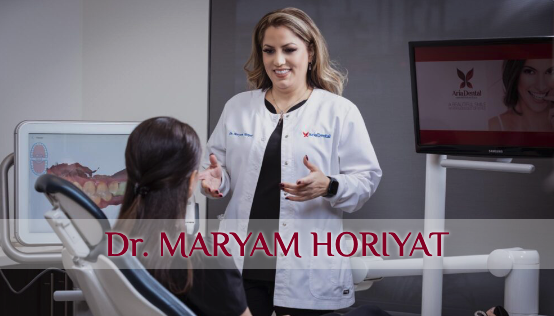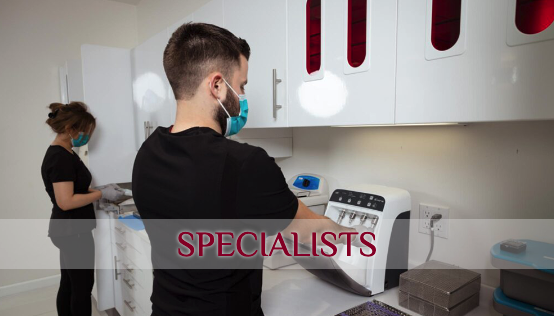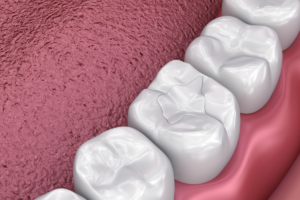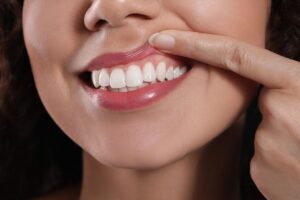Having heard all that from Dr. Horiyat, let’s get into more details right away!
If you have ever been to a dentist, or seen one on TV, you know there is a device with a tiny stick in the middle that people put in their mouths and bite on, and then a rotary device rotates around their head for some time. That’s it! That’s A Dental Cone Beam! That’s what we are going to talk about in this entire blog because there is more to what you have seen with this device. First, take a look at what Dr. Horiyat has to say about this cutting-edge technology in the above video.
What Is Dental Cone Beam CT?
Dental Cone Beam Computed Tomography (a.k.a CBCT) is a very specific kind of X-ray machine that is mainly used when a 3D model of the system is required rather than just having a 2D image. These are most often used for dental & maxillofacial (a.k.a face & jaw) treatments.
Images created with CBCT are way more accurate than traditional dental CT scans and provide a 3D model of the entire jaw. This means that, using a computer, your dentist can see what is happening within your mouth more clearly and precisely. What’s more is that the image quality itself is much higher with cone beam CT compared to the traditional ones.
Cone Beam CT vs. Traditional Dental CT
So let’s first have a comparison between a cone beam CT and a traditional dental CT. So far, you should have realized that a dental CT and a cone beam CT are not the same. Although both CT scanners can provide three-dimensional pictures of the mandible, the older dental CT transmits radiation in the shape of a spiral or helix using a fan beam.
However, here’s where the important stuff happens. A cone-shaped X-ray beam spins around the patient’s head during a cone beam CT scan, producing 150–200 high-resolution two-dimensional pictures. These images are then digitally merged to create a three-dimensional image. This is the main reason why a cone beam CT is most often favored over the traditional CTs. Using this technology, your dentist can examine three-dimensional cross-sections of your jaw and teeth with a Cone Beam CT scan.
Furthermore, a cone beam computed tomography may reveal illnesses of the sinuses, nasal cavity, jaw, teeth, and bone structures of the face much more accurately and efficiently.
What’s The Difference In X-ray Beam Radiation Exposure?
When it comes to X-ray machines, one of the most important factors is the amount of radiation produced and beamed to the patients. Basically, the lower the amount of radiation, the better it is. As a holistic practitioner, Dr. Horiyat always insists on using the most advanced technology in our office to make sure the overall health of our patients is not compromised by a single treatment.
In conventional dental CT machines, a rotating, high-output anode X-ray tube is used which is essentially an older technology that dates all the way back to the 1970s. That is a little after the Apollo mission and way before Elvis died!
Medical fluoroscopy tubes with low power consumption are used in Cone Beam CT scanners. There will be less radiation surrounding the patient at a lower power level. With 200–300 times less radiation exposure during panoramic radiography, a cone beam CT moves more quickly than a dental CT scanner but beams out less radiation to the patient, which is a very good thing.
What Are Some Use Cases of Cone Beam CT?

The truth is that the cone beam CT is utilized for a large number of treatments. It mostly comes in handy when planning for a treatment where the entire structure of the jaw, teeth, and face is necessary. Some examples of this in dentistry include orthodontics and dental implants. What is apparent is that cone beam CT is considered to be one of the most game changing and revolutionary advancements of the common era.
Orthodontics and dental implants aside, it is also used for other more complex treatments such as:
- Surgical planning for impacted teeth.
- Diagnosing temporomandibular joint disorder (TMJ).
- Evaluation of the jaw, sinuses, nerve canals, and nasal cavity.
- Detecting, measuring, and treating jaw tumors.
- Determining bone structure and tooth orientation.
- Locating the origin of pain or pathology.
- Cephalometric analysis.
- Reconstructive surgery.
- Accurate and safe placement of dental implants.
So How Do You Prepare For A Cone Beam CT Exam?
Well there is not much you should do from home. It is very similar to the conventional CT exams that we have all been through. All you need to do is to try avoiding metal accessories and wear your comfortable, loose clothes.
Once you enter the room, right before the examination the staff may ask you to take off anything that might affect the imaging such as the previously mentioned metal accessories, any jewelry, glasses, hearing aids and bobby pins.
When it comes to your dental wearables, we often recommend you carry these removable dental works with you and allow your dentist to examine them as necessary. Having them with you is less harmful than not having them.
One big factor that you must consider at all times no matter what, is pregnancy. All women must inform their dentists or oral surgeons if they are pregnant or even suspicious of such fortunes. It is solely the duty of your dentist to then decide, based on your condition, that whether you can take the cone beam CT scan or if there are any kinds of precautions necessary.
How Is It Done?

Ok now that you are all set and prepared let’s talk about how it is actually done!
The procedure is actually quite simple. Depending on your examination and the type of machine that is present, you may be asked to stand or sit in the radiography room. Then our assistants will help you get in the proper position. This position is important as your dentist may want to get images of a certain angle.
While the cone beam CT is rotating around your head, it is very important that you remain still. This is crucial for getting a perfect 360-degree image.
The device is made up of an X-ray source and a detector. These are mounted on the opposite side of one another. The two pieces will rotate together in order to achieve the most dynamic imaging possible. In just one rotation, the system can easily produce over 200 high-res 2D images. The same system will later produce a 3D image by digitally combining all the 2D pictures.
The entire procedure (from when the arms start rotating to the end) is going to take no more than 25 seconds and that is for a full mouth x-ray. That means the entire body of your mouth, dental structure along with your jaw details are imaged. If the aim of your cone beam CT is to achieve a regional scan, it should not take over 10 seconds.
What Will I Experience During & After The Procedure?
Honestly, your experience is not going to be much different from a normal x-ray scan. There will be no pain, no discomforts, no feelings of agitation, no irritations, basically nothing. Also, there have been no reports of nausea during or after the procedure. It is important to note that all the imaging equipment present at Aria Dental Care is safe for all patients and is approved by the ADA (American Dental Association) along with the Food & Drug Administration (FDA) so you do not have to worry about any radiations or other harmful issues that you may face in other conventional dental clinics.
How Do I Know What The Results Mean?

Technically, it is not for you to interpret the results, that is actually a very professional thing that your dentist will do. They will analyze the images with regard to your medical condition and plan out your treatment accordingly. In some rare cases, your dentist will have to get a hand from a dental radiologist, maxillofacial surgeon or any other specialist to further interpret your cone beam CT results. For example, when it comes to observing things such as soft tissues, and bone density, it is always a good idea to ask for a second or even third opinion from a dental radiologist.
Your dentist will most likely let you know about some of the highlights of your results and won’t leave you in the dark.
Do You Offer Cone Beam Ct?
Yes! At Aria Dental Care we believe only in the best and holistic treatments and that is why we use a cone beam CT for most of the treatments. While all the treatments are carried out under the supervision of Dr. Horiyat herself, it is important to note that all our specialists are fluent in reading and interpreting the results coming from cone beam CTs. We specifically use this technology to observe and plan treatments for patients who need orthodontics and dental implant implantation. Don’t forget to contact us using this link, by clicking the call button on the top right of the page or clicking on the banner below!



















